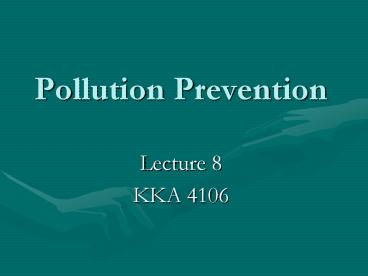Pollution Prevention - PowerPoint PPT Presentation
1 / 14
Title:
Pollution Prevention
Description:
Minimize concentration of metal in plating bath - Rack bars to maximize drainage - Drip bars to hold racked parts over plating baths - Maximize hole size on barrels ... – PowerPoint PPT presentation
Number of Views:41
Avg rating:3.0/5.0
Title: Pollution Prevention
1
Pollution Prevention
- Lecture 8
- KKA 4106
2
Pollution Prevention
- To examine practices that reduce or eliminate
hazardous waste at the source
3
General Considerations
- Methods and EPA hierarchy. (F7-1)
- - Source reduction
- - Recycling
- - Treatment
- - Disposal
- Waste Minimization. Any management technique or
process modification that ultimately reduces the
mass or toxicity sent on to treatment, storage
and disposal facilities. - Economic Incentives.
4
General Considerations
- Legal and Regulatory Incentives.
- Generators must certify that a waste minimization
is in place. - In 1991, the EPA instituted a voluntary 33/50
program which had an overall national goal of 50
reduction in the generation of 17 high-priority
toxic chemicals by 1995. (T7-1). - Public Incentives. No public will no longer
tolerate hazardous wastes.
5
Management Strategies
- Planning
- Characterization of waste
- Options
- Feasibility
- Implementation
- Monitoring and optimization
6
Life Cycle Analysis ( LCA )
- LCA considers the impact of all phases of
industrial activity, from raw materials,
acquisition and RD to the final disposition of a
product and its packaging. - LCA provides an analytical framework for
investigating the entire range of environmental
impacts air emissions, wastewater, solid and
hazardous waste, renewable resources and energy
utilization. - BMW introduced a car line in which the plastic
(typical car 180 lbs) parts are stamped by type
during fabrication. The cars are designed for
disassembly.
7
Volume Reduction
- Reducing volume without reducing toxicity are
sometimes explicitly excluded from the definition
of source reduction. - Consists of 3 steps
- Process modification
- Segregation
- Re-use
8
Process Modifications
- Raw Materials.
- Replace solvent based cleaners with water based
cleaners. - Equipment.
- Operating Procedures
- Materials Storage
- End Products
9
Process Modifications
- A special and pervasive case, reducing dragout in
the electroplating industry. - - Increase drain time
- - Low pressure air, air knife
- - Spray rinsing over process tank
- - Minimize concentration of metal in plating
bath - - Rack bars to maximize drainage
- - Drip bars to hold racked parts over plating
baths - - Maximize hole size on barrels
- - Rotate barrels above plating tank
10
Segregation
- A primary tenet of source reduction is to avoid
mixing wastes. A small amount of hazardous waste
mixed with a large amount of non-hazardous waste
creates a large amount of hazardous waste.
Segregation permits treating smaller quantities
of waste. - Keep non-contact cooling water and domestic waste
away from hazardous waste streams.
11
Re-use
- Reclaiming a hazardous waste for use in another
application. - Toluene used for cleaning one ink is used to thin
an ink of another color.
12
Toxicity Reduction
- It is often possible to lessen the toxic
characteristics sufficiently so that the
remaining waste is no longer considered a
hazardous waste. - Process Modification. Dry powder painting instead
of using solvent based paints. - Equipment Modification. Alarms to avoid bumps.
- Housekeeping. (T7-7)
- Simplest and most inexpensive method of reducing
hazardous waste. Includes training, using
pallets to discern leaks. - Material Substitution. Non-cyanide baths in metal
plating.
13
Recycling
- Water.
- Combine acid and alkalis.
- Use water for a less sensitive use. Non-contact
cooling water. - Solvents. (T7-8)
- Azeotropic distillation. An azeotrope is a
mixture of liquids that behave as a single
substance when boiled i.e. the vapor and the
liquid have the same composition. Azeotropic
distillation consists of adding a substance,
typically steam, to a solvent that is to be
recycled. The azeotrope has a lower boiling point
than the original mixture thus facilitating the
recovery of the solvent. Small package
distillation plants are readily available.
14
Recycling
- Oil.
- Refined and reused.
- Use for heat value.
- Solids
- Paper, metal, plastics.
- Waste Exchanges.
- A regional clearing house to facilitate waste
exchange. - The first take is to exchange at the same
location to avoid transportation liabilities.































